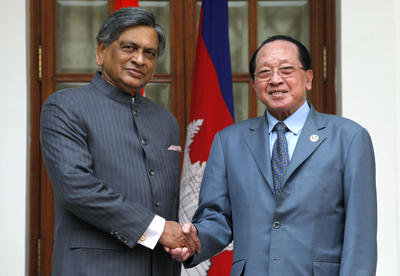One notable change is the entry into force of the ASEAN Charter in 2008. The charter provides that the ASEAN chairmanship coincide with the calendar year; that ASEAN Summits take place twice a year instead of only once; and that the chairmanships of most ASEAN bodies, to the extent possible, be bundled into the same country. Chairing and hosting ASEAN meetings means that Cambodia has much on its plate this year. But beyond the meetings, Phnom Penh must face up to a range of difficult issues as chair.
One issue is that the risk of more violent clashes between Cambodian and Thai armed forces, over the disputed border area around the 11th-century Preah Vihear temple, presents Cambodia with a potential conflict of interest. The most recent clashes erupted in 2008 when UNESCO listed Preah Vihear, which the International Court of Justice had awarded to Cambodia in 1962, as a World Heritage Site. In February 2011, the UN Security Council called on both sides to establish ‘a permanent ceasefire’ and ‘expressed support for ASEAN’s active efforts’ to pacify conflict along the border. Following the Security Council’s recommendation that both parties cooperate with ASEAN to end the armed conflict, Cambodia and Thailand’s foreign ministers agreed to allow a team of unarmed Indonesian observers to monitor the ceasefire on the ground. And in July 2011 the International Court of Justice in The Hague ordered the two sides to withdraw their forces from a designated demilitarised zone and to continue to cooperate within ASEAN. During its 2012 chairmanship, Cambodia will need to navigate between its status as a protagonist in the dispute with Thailand and its role as the chair of ASEAN.
Another issue is the dispute over the South China Sea, where four ASEAN members and China/Taiwan have overlapping claims. As a non-claimant, Cambodia needs to forcefully articulate the association’s position on regional peace and stability, the rule of international law, and freedom of navigation and overflight. This could be a testing task, as Cambodia is beholden to China for its valued investments and development aid.
There is also a disagreement within ASEAN on Timor-Leste’s application for membership. It will fall upon Cambodia to lead the efforts in resolving this apparent dispute.
In terms of ASEAN’s internal affairs, Cambodia may be required to preside over preparations for a review of the ASEAN Charter — something that is called for five years after its entry into force, or at the end of 2013. As chair of the ASEAN Economic Ministers Meeting and of ASEAN itself, Cambodia is expected to help member states carry out individual commitments outlined in the ASEAN Economic Community Blueprint by the self-imposed 2015 deadline.
Beyond Southeast Asia, on the international stage, Cambodian Prime Minister Hun Sen will likely be invited to the next G20 Summit in his capacity as ASEAN chair. He will be called upon to express ASEAN’s views on weighty questions about the global economy such as economic re-structuring and governance of international financial institutions.
Cambodia’s chairmanship of ASEAN also comes at a time of heightened US efforts to link up more tightly with East Asia, including with and through ASEAN. These efforts raise some vital questions, not least for Cambodia as ASEAN chair: Will the US’s refusal to be a party to the Comprehensive Economic Partnership for East Asia (CEPEA), which is based on the EAS, undermine the CEPEA or even the EAS itself? Will US interest in joining the Trans-Pacific Partnership (TPP) prevent a division of the Pacific ‘down the middle’, as Washington insists? And what will be the effects of China’s possible exclusion from the TPP?
With Cambodia as chair, ASEAN has to show its non-ASEAN East Asian partners that it can lead East Asian regionalism with useful and realistic ideas, instead of simply managing the process, setting up the administrative arrangements and negotiating the chairman’s statements.
Rodolfo C. Severino is Head at the ASEAN Studies Centre, Institute of Southeast Asian Studies, Singapore, and a former ASEAN Secretary-General.
A longer version of this article first appeared here in aSEAn Focus.


I found your article very interesting. However, the two final paragraphs in your piece look as if they raise a critical question about Cambodia’s Chairmanship of ASEAN in 2012 while ASEAN as whole have naturally been facing this kind of question on its centrality in East Asian regionalism.
It seems unfair for Cambodia to solely receive that kind of concern on ASEAN leadership since ASEAN itself is doubted by many other non-ASEAN countries in respect its driving role in the evolving regional architecture.
Instead, Cambodia should receive strong support from fellow ASEAN countries, its dialogue partners, and the ASEAN Secretariat to help improving ASEAN leadership in regional community building and to overcome regional barriers to successfully achieve ASEAN community by 2015, as stated in Cambodia’s theme for ASEAN 2012 “ASEAN: one community, one destiny”.
thanks for all the information guys